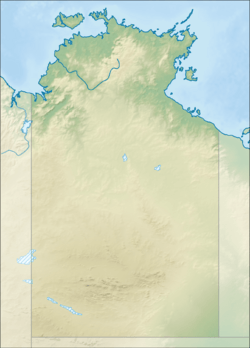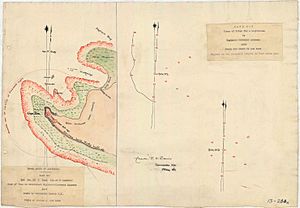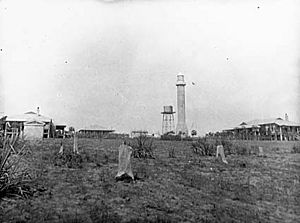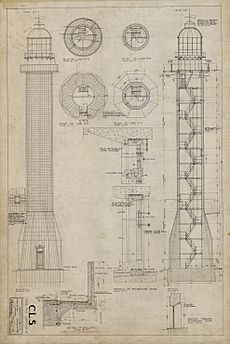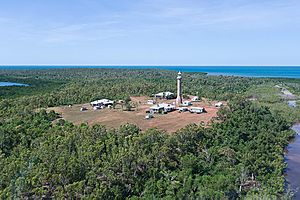Cape Don Light facts for kids
 |
|
| Cape Don Lightstation. One of the keeper's cottages visible to the right. | |
|
|
|
| Location | Cobourg Peninsula Northern Territory Australia |
|---|---|
| Coordinates | 11°18′28.36″S 131°45′54.56″E / 11.3078778°S 131.7651556°E |
| Year first constructed | 1917 |
| Automated | 1983 |
| Construction | reinforced concrete tower |
| Tower shape | cylindrical tower on octagonal prism basement with balcony and lantern |
| Markings / pattern | unpainted tower, white lantern |
| Height | 118 feet (36 m) |
| Focal height | 163 feet (50 m) |
| Original lens | Chance Brothers 3rd order Fresnel lens |
| Intensity | 260,000 cd |
| Range | 22 nautical miles (41 km) |
| Characteristic | Fl W 10s. |
| Admiralty number | K3314 |
| NGA number | 111-9548 |
| ARLHS number | AUS-028 |
The Cape Don Light is an important lighthouse located in the Northern Territory of Australia. It stands on Cape Don, which is the very tip of the Cobourg Peninsula. This lighthouse helps guide ships safely into the Dundas Strait. It is the most northern traditional lighthouse in Australia.
The lighthouse station was very important for ships traveling to Darwin. It marked a key route between the peninsula and Melville Island. The main tower was built between 1915 and 1917. This time was known as the "Golden Age of Australian Lighthouses." The lighthouse was staffed by keepers until 1983. During this time, the keepers also kept weather records. These records were very helpful for tracking cyclones as they formed. The lighthouse complex includes the main tower, three homes for the keepers, and other smaller buildings.
Cape Don was named in 1818 by Phillip Parker King. He named it after General Sir George Don, who was the Lieutenant-Governor of Gibraltar.
Contents
Building the Cape Don Light
In 1911, the Northern Territory became part of the federal government. The Commonwealth Lighthouse Service was created in 1915. One of its first jobs was to build a lighthouse on the Cobourg Peninsula. This was because the sea route to Darwin, between the peninsula and Melville Island, was very important. Building the Cape Don tower was the biggest project for the Lighthouse Service during its "Golden Age" (1913–1920).
Challenges of Construction
Work on the lighthouse started in May 1915. An iron structure was not suitable because of the tropical weather. Also, the local stone was not good for making concrete. So, all the building materials had to be shipped from Melbourne.
The ships could not land directly at the lighthouse site. The closest place to unload materials was about 3 miles (5 km) away at Christies Bay. Workers built a jetty and a small railway to move the materials. Horses pulled the materials from the landing spot.
The hot climate and the hilly ground made work very slow. Only two trips could be made each day. Also, construction could only happen during the dry season, from April to November. Because of these challenges, building the lighthouse took three years. It was finally finished in June 1917.
The Light Begins to Shine
The lantern was installed and ready to be lit in August 1917. But then, an earthquake shook the tower. The building itself was not damaged. However, some of the liquid mercury from the light's rotating base was lost. The lighthouse was officially lit on September 15, 1917.
The first light source used a special type of kerosene lamp. It was very bright, with an intensity of 150,000 cd. Its light could be seen from 23 nautical miles (43 km; 26 mi) away. The original lens was a large Fresnel lens made by Chance Brothers. The light rotated on a base that floated in mercury. A clockwork system, powered by weights, made it turn. This system only needed to be wound up every twelve hours.
Changes Over Time
During the Second World War, a radar station was set up near the lighthouse. This helped to detect enemy planes or ships.
In the early 1970s, the lighthouse was updated. It was connected to generators that ran on diesel fuel. The light source was changed to a 120-volt halogen lamp.
In 1983, the light became automated. This meant that lighthouse keepers were no longer needed to live and work there. The new system uses four vertical panels with special reflectors. It has 12-volt watt quartz halogen lamps. The light rotates three times per minute. It flashes white once every 10 seconds. This light is very bright, at 260,000 cd, and can be seen for 22 nautical miles (41 km; 25 mi). The light is now powered by solar power. It was the first lighthouse in Australia to use this kind of power. At the same time, the keepers' cottages were given to the Northern Territory Conservation Commission.
In 2005, the original lens and its rotating parts were found in storage. They were then given to the Queensland Maritime Museum in Brisbane.
What the Lighthouse Looks Like
The Cape Don Light tower is 28 metres (92 ft) tall from the ground to its top platform. Its base is round, but it sits on an eight-sided (octagonal) bottom section. On top of the platform is the original lantern room, which is about 3.25 meters wide.
Keeper's Cottages
There are three homes for the former lighthouse keepers at the site. They are built from concrete blocks. They stand on tall blocks with strong concrete beams. The homes have wooden floors and wide wooden verandahs. These verandahs can be closed off with pivoting storm screens. The original roofs were made of corrugated iron. One house later had its roof changed to corrugated asbestos cement.
Originally, a wide open space called a breezeway divided each house into two parts. One part had three rooms, and the other had two larger rooms. A hallway between them led to double doors opening onto the verandah. Some of these buildings have been changed. The original breezeway in some houses has been turned into a living area.
Other Buildings and Features
The complex also has small concrete block storage sheds next to each house. There are also block work sheds around the main tower. Other sheds made of galvanised iron include a powerhouse, a workshop for repairs, and a store.
At the northern edge of the complex, there is a water bore and a mill. An old, unused garden is next to it. The original raised water tank is in the middle of the complex.
The path of the old tramway, which went from the lighthouse to Christies Bay, can still be seen. Parts of the narrow gauge tramway are still there, except near the bay. At the end of the tramway, there is a causeway about 90 metres (300 ft) long and 4 metres (13 ft) wide. It goes through a mangrove swamp into the bay. There is a shelter at its end. The old jetty is gone, but the upright tramway rails that supported it are still visible.
Who Manages the Site?
The light itself is managed by the Australian Maritime Safety Authority. The land and buildings are managed by the Garig Gunak Barlu National Park authorities.
Visiting the Lighthouse
You can reach the Cape Don Light by a 4WD car, but only during the dry season (May to October). You will need special permits and must pay a fee. You can also get to the site by plane or boat. The lighthouse tower itself is not open to visitors. However, the house where the head lighthouse keeper used to live has been turned into a fishing lodge. You can stay there overnight.


